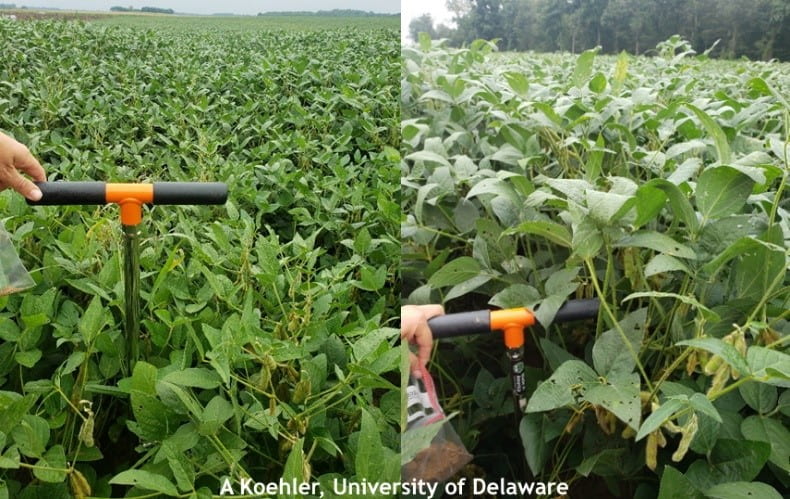Alyssa Koehler, Extension Field Crops Pathologist; akoehler@udel.edu
In the June 19 issue of WCU (https://sites.udel.edu/weeklycropupdate/?p=15246) we spoke about scouting for Soybean Cyst Nematodes in early season plants. While checking roots can give an idea about in-season infection, soil samples are the best method to assess overall populations across the field. Soil sampling can be conducted at any time, but fall samples provides the optimal snapshot for end of season populations and samples can be collected when already out for routine fertility sampling. Nematode soil samples can be diagnostic or preventative. Diagnostic samples tend to target areas of the field where plants look stunted or notably different from the rest of the field. For diagnostic samples, it is helpful to sample from the problem area and nearby healthier plants (Figure 1). Preventative samples are geared towards fields where you are interested in collecting a random sample to learn about the field as a whole. Preventative samples can be collected in a “zigzag” or “W” pattern across the field. Soil samples should be collected from the plant root zone 6-8” deep using a soil probe. Ideally, you want to mix at least 15-20 soil cores for every 20 acres for preventative samples. More cores from smaller areas will improve the accuracy of samples. Aim to collect about a quart size zip lock full of the mixed soil cores (Figure 2). Soil samples can be sent to the NCDA Nematode Assay Service https://www.ncagr.gov/agronomi/uyrnem.htm. At this time, the VT Nematode Diagnostic Lab is closed. When collecting and storing samples, avoid heating, drying, adding water, or freezing. Optimal temperatures for the collected samples are 56-64°F. In 2021, my research program will be expanding efforts to survey nematodes across DE and MD, if you have soybean fields that you would like sampled please contact me at akoehler@udel.edu.
Figure 1. Stunted plants (left) located approximately 15 feet from plants that were 2-3 feet taller (right). A diagnostic sample can be collected from the “bad” and “good” areas to determine if nematodes are contributing to the stunting.
Figure 2. Ziploc bag filled with mixture of soil cores collected by walking a “W” shape in the field.


